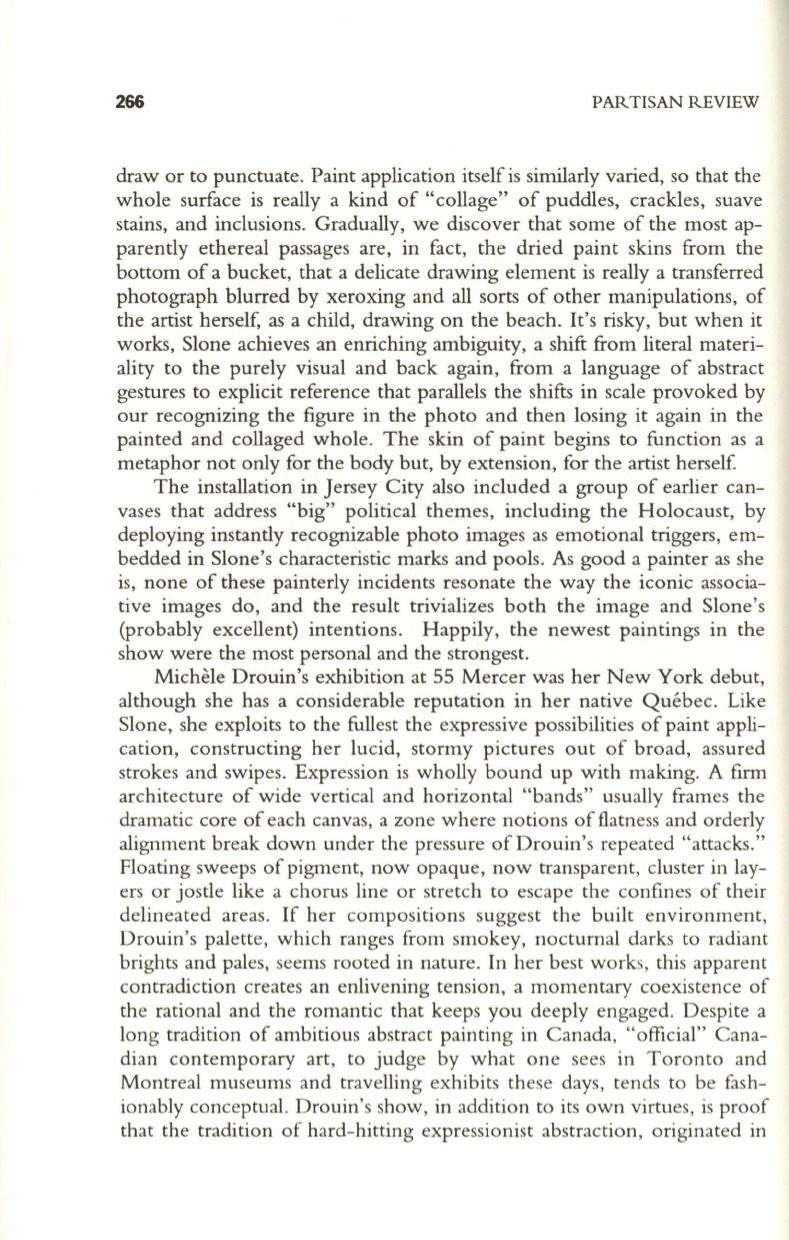
266
PARTISAN REVIEW
draw or to punctuate. Paint application itself is similarly varied, so that the
whole surface is really a kind of "collage" of puddles, crackles, suave
stains, and inclusions. Gradually, we discover that some of the most ap–
parently ethereal passages are, in fact, the dried paint skins from the
bottom of a bucket, that a delicate drawing element is really a transferred
photograph blurred by xeroxing and all sorts of other manipulations, of
the artist herself, as a child, drawing on the beach. It's risky, but when it
works, Slone achieves an enriching ambiguity, a shift from literal materi–
ality to the purely visual and back again, from a language of abstract
gestures to explicit reference that parallels the shifts in scale provoked by
our recognizing the figure in the photo and then losing it again in the
painted and collaged whole. The skin of paint begins to function as a
metaphor not only for the body but, by extension, for the artist hersel£
The installation in Jersey City also included a group of earlier can–
vases that address "big" political themes, including the Holocaust, by
deploying instantly recognizable photo images as emotional triggers, em–
bedded in Slone's characteristic marks and pools. As good a painter as she
is, none of these painterly incidents resonate the way the iconic associa–
tive images do, and the result trivializes both the image and Slone's
(probably excellent) intentions. Happily, the newest paintings in the
show were the most personal and the strongest.
Michele Drouin's exhibition at 55 Mercer was her New York debut,
although she has a considerable reputation in her native Quebec. Like
Slone, she exploits to the fullest the expressive possibilities of paint appli–
cation, constructing her lucid, stormy pictures out of broad, assured
strokes and swipes. Expression is wholly bound up with making. A firm
architecture of wide vertical and horizontal "bands" usually frames the
dramatic core of each canvas, a zone where notions of flatness and orderly
alignment break down under the pressure of Drouin's repeated "attacks."
Floating sweeps of pigment, now opaque, now transparent, cluster in lay–
ers or jostle like a chorus line or stretch to escape the confines of their
delineated areas. If her compositions suggest the built environment,
Drouin's palette, which ranges from smokey, nocturnal darks to radiant
brights and pales, seems rooted in nature. In her best works, this apparent
contradiction creates an enlivening tension, a momentary coexistence of
the rational and the romantic that keeps you deeply engaged. Despite a
long tradition of ambitious abstract painting in Canada, "official" Cana–
dian contemporary art, to judge by what one sees in Toronto and
Montreal museums and travelling exhibits these days, tends to be fash–
ionably conceptual. Drouin's show, in addition to its own virtues, is proof
that the tradition of hard-hitting expressionist abstraction, originated in


